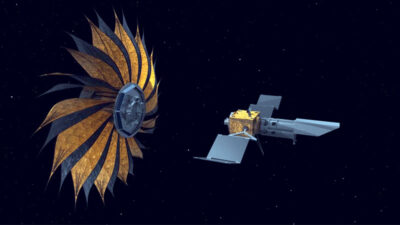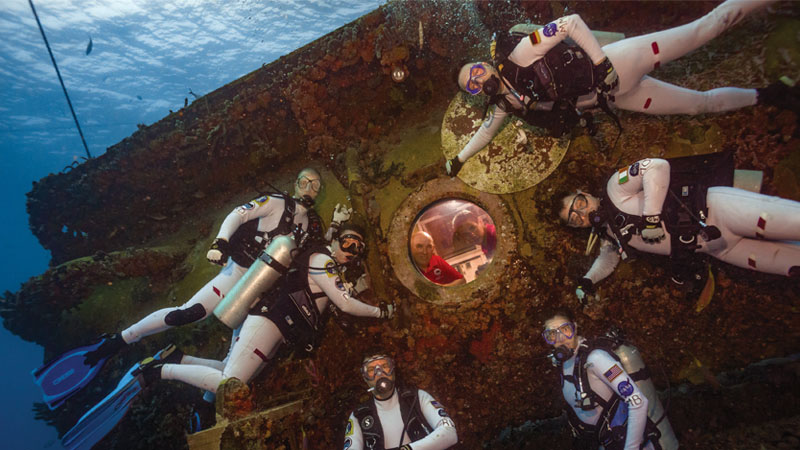Robotics for in-space servicing, assembly and manufacturing is key for sustainable space infrastructure
By Samantha Glassner, Erik Komendera and Jian-Feng Shi|December 2022
The Space Automation and Robotics Technical Committee works to advance the development of automation and robotics technologies and their applications to space programs.
NASA’s James Webb Space Telescope completed sunshield and mirror segment deployment sequences in January after it was launched on Dec. 25, 2021. According to NASA’s press release, the deployment required 178 release mechanisms, 139 just for the sunshield, including “70 hinge assemblies, eight deployment motors, roughly 400 pulleys, and 90 individual cables.” These robotic operations had to go flawlessly to get the telescope operational. U.S. President Joe Biden revealed the telescope’s first images in July.
In February, Tokyo-based GITAI completed an autonomous demonstration of its 2-meter In-Space Servicing, Assembly, and Manufacturing, or ISAM, robotic arm inside the Japan Aerospace Exploration Agency’s 8-meter thermal vacuum chamber, assembling a solar panel and exchanging an orbital replacement unit. This experiment parallels GITAI’s autonomous demonstration conducted in the International Space Station’s Nanoracks Bishop Airlock last October and provides confidence for its 2023 planned demonstration outside the ISS. GITAI is also developing R1, a lunar robotic rover it tested in JAXA’s mock lunar surface in December 2021, and S10, a 10-meter robotic arm that completed a proof-of-concept test corresponding to NASA’s technical readiness level 3 in August.
In February, Northrop Grumman’s SpaceLogistics announced the first sale of a Mission Extension Pod and a launch agreement for a Mission Robotic Vehicle spacecraft. These missions build on the successful docking of the Mission Extension Vehicle-2 onto Intelsat 10-02 in April 2021, the first satellite life-extension services flight example.
In March, the U.S. Defense Department’s Defense Innovation Unit put out a solicitation for proposals for a geosynchronous orbit commercial satellite refueling service and a bulk fuel depot. DIU also continued work on its Modularity for Space Systems project, which has modular satellite systems under development by Colorado-based Maxar Technologies, California-based Motiv Space Systems and Washington-based Tethers Unlimited.
In March, DARPA kicked off its Novel Orbital Moon Manufacturing, Materials, and Mass Efficient Design, or NOM4D, program by contracting eight university and industry teams to provide proof of concepts for aspects of in-space manufacturing. In a press release, program manager Bill Carter said the needed technology innovations include “robotic manipulation sufficient to enable assembly of large structures from NOM4D-manufactured components, enhanced on-orbit mobility, and routine re-fueling of on-orbit assets.”
In March, Canada-based MDA began preliminary design of the robotic arm for NASA’s lunar Gateway space station. In April, MDA announced a partnership with Lockheed Martin and General Motors to integrate commercial robotic arm technology on their human-rated lunar mobility vehicles. In May, MDA was contracted to deliver 32 Canadarm3 external robotic interfaces for the Axiom Station, a commercial space station under development by Axiom Space of Texas. In July, the Canadarm2 on ISS assisted with trash disposal for the first time. The Materials International Space Station Experiment-16 began in July, when the Canadarm2 and Dextre robots transferred the MISSE tray from the Japanese airlock to the facility worksite, completing the first demonstrations of the mobile servicing system application computer.
In April, the White House’s National Science and Technology Council released the first ISAM national strategy document outlining a strategy for the U.S. government regarding challenges and strategic goals for ISAM.
In April, MIT’s TESSERAE project, short for Tessellated Electromagnetic Space Structures for the Exploration of Reconfigurable, Adaptive Environments, tested autonomously self-assembling tiles into a dome configuration and disassembling them using electropermanent magnets. The tiles launched to ISS in April as part of Axiom’s Ax-1 mission.
NASA’s Volatiles Investigating Polar Exploration Rover will explore the lunar south pole in 2024 to prospect for volatiles near Nobile Crater. The third generation of the test version, the Moon Gravity Representation Unit, arrived at the Simulated Lunar Operations Lab at NASA’s Glenn Research Center in Ohio, where system-level mobility verification testing was conducted by driving over a variety of terrain including slopes, rocks and craters.



































